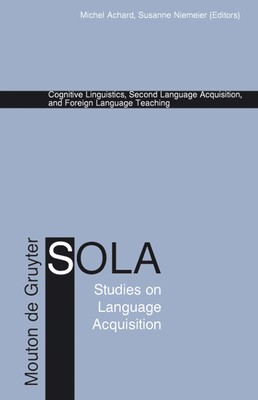
- We will send in 10–14 business days.
- Publisher: Walter de Gruyter
- Year: 2004
- Pages: 289
- ISBN-10: 3110173573
- ISBN-13: 9783110173574
- Format: 15.6 x 23.4 x 1.8 cm, hardcover
- Language: English
- SAVE -10% with code: EXTRA
Cognitive Linguistics, Second Language Acquisition, and Foreign Language Teaching (e-book) (used book) | bookbook.eu
Reviews
Description
This collection of twelve papers demonstrates that the concepts developed within the Cognitive Linguistics movement afford an insightful perspective on several important areas of second language acquisition and pedagogy.
In the first part of the book, three papers show how three Cognitive Linguistics constructs provide a useful theoretical frame within which second language acquisition data can be analyzed. First, Talmy's typology of motion events is argued to constitute the base relative to which acquisition discrepancies in motion events are most valuably investigated. Secondly, the notion of "construction" is invoked in order to account for systematic differences between the native and non-native speakers' use of the English verb get. Finally, frequency and similarity effects are shown to play a crucial part in the learning of prepositions in a second language.
The second part of the book shows that the key concepts commonly invoked in Cognitive Linguistics analyses allow language teachers to insightfully structure the presentation of problematic material in the foreign language classroom. These concepts include among others polysemy, the figure/ground gestalt, the usage-based conception of grammar, the radial organization of categories, metaphors, and cultural scripts. The Cognitive Linguistics paradigm has already shown its viability to analyze a wide array of linguistic phenomena.
This book establishes its relevance in the areas of second language acquisition and language pedagogy. Its intended public is composed of Cognitive Linguists, Second Language Acquisition specialists, as well as foreign language pedagogy researchers, instructors, and students.
EXTRA 10 % discount with code: EXTRA
The promotion ends in 10d.19:18:51
The discount code is valid when purchasing from 10 €. Discounts do not stack.
- Publisher: Walter de Gruyter
- Year: 2004
- Pages: 289
- ISBN-10: 3110173573
- ISBN-13: 9783110173574
- Format: 15.6 x 23.4 x 1.8 cm, hardcover
- Language: English English
This collection of twelve papers demonstrates that the concepts developed within the Cognitive Linguistics movement afford an insightful perspective on several important areas of second language acquisition and pedagogy.
In the first part of the book, three papers show how three Cognitive Linguistics constructs provide a useful theoretical frame within which second language acquisition data can be analyzed. First, Talmy's typology of motion events is argued to constitute the base relative to which acquisition discrepancies in motion events are most valuably investigated. Secondly, the notion of "construction" is invoked in order to account for systematic differences between the native and non-native speakers' use of the English verb get. Finally, frequency and similarity effects are shown to play a crucial part in the learning of prepositions in a second language.
The second part of the book shows that the key concepts commonly invoked in Cognitive Linguistics analyses allow language teachers to insightfully structure the presentation of problematic material in the foreign language classroom. These concepts include among others polysemy, the figure/ground gestalt, the usage-based conception of grammar, the radial organization of categories, metaphors, and cultural scripts. The Cognitive Linguistics paradigm has already shown its viability to analyze a wide array of linguistic phenomena.
This book establishes its relevance in the areas of second language acquisition and language pedagogy. Its intended public is composed of Cognitive Linguists, Second Language Acquisition specialists, as well as foreign language pedagogy researchers, instructors, and students.


Reviews